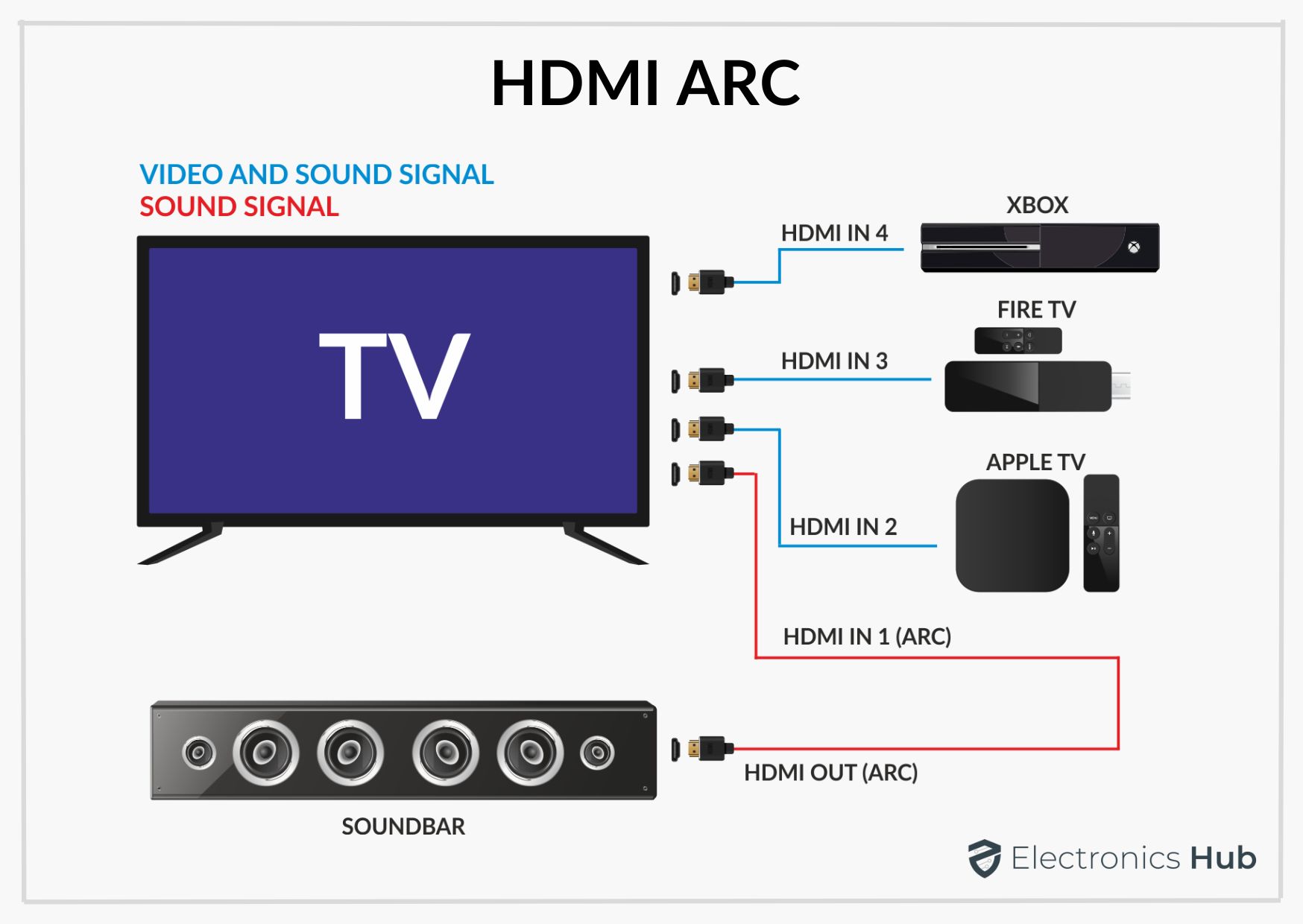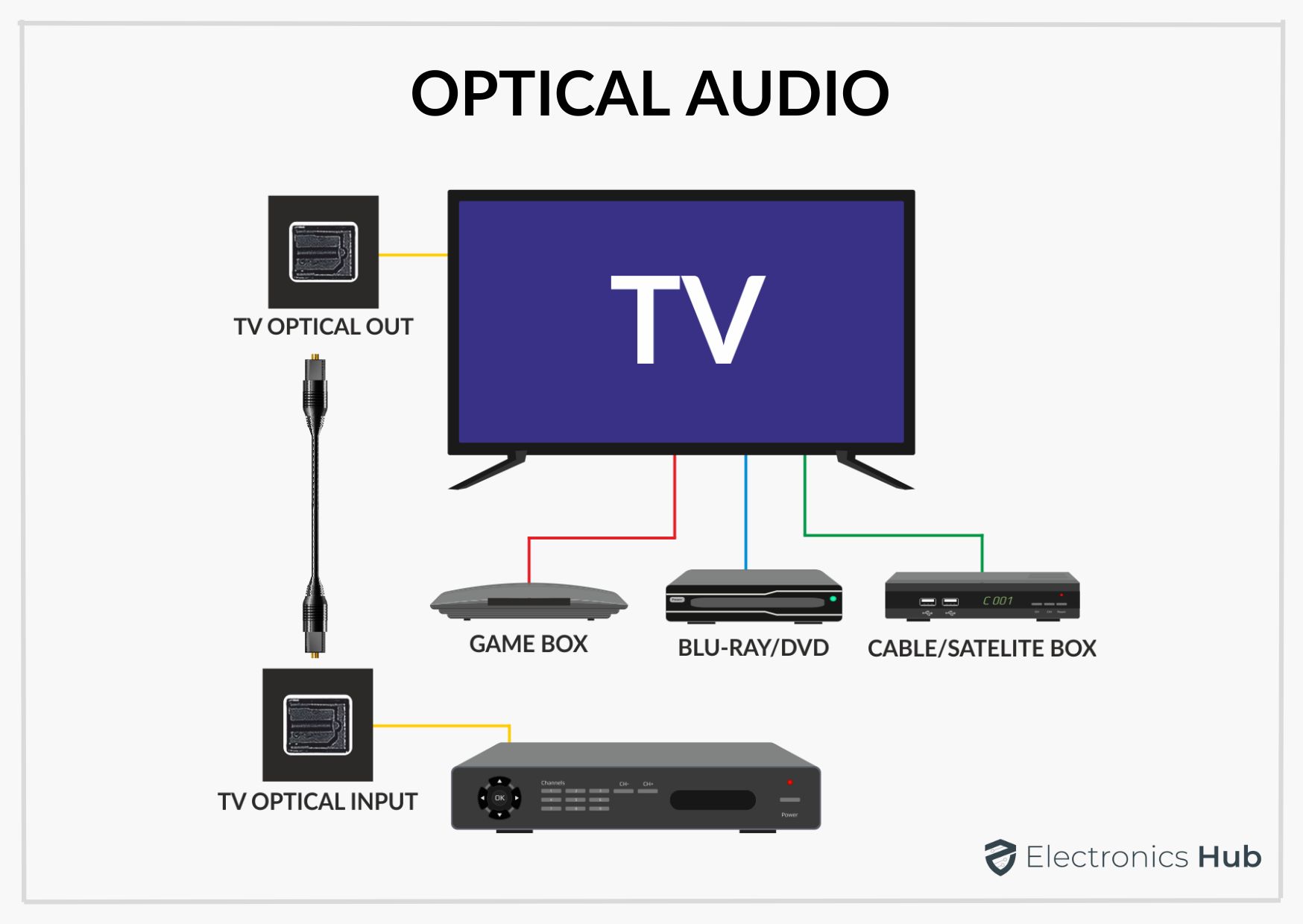We all know that the sound from our TVs is not the best (to be polite). While picture quality has undergone significant improvements over the years, audio from TV is mediocre. For this reason, we rely on external speaker in the form of soundbars or surround sound systems.
The setup process is also simple. Just connect the source (set top box, Blu-Ray Player, Gaming Console, HTPC, or any other) to an HDMI port on the TV. Coming to audio, you can use either an optical cable or use HDMI ARC to send audio from TV to external speakers.
Optical Audio uses light to transmit audio signals using fiber optic cable. HDMI ARC on the other hand uses a regular HDMI cable to transmit audio signals. Both these cables can transmit multi-channel audio from your TV to the speakers.
We will compare HDMI ARC vs Optical Audio in this guide and determine which one is the best option for you.
Outline
ToggleWhat is HDMI ARC?

HDMI Forum introduced HDMI ARC starting with HDMI 1.4 Specification back in 2009. Without HDMI ARC, the setup would be something like this: connect all the inputs sources to an AV Receiver, connect the AV Receiver to the TV and run an additional audio cable (usually an optical cable) back to the AV Receiver.
With the introduction of HDMI ARC, you don’t need that extra audio cable as the single HDMI cable between the TV and the AV Receiver can take care of the upstream (send video to TV) and downstream (return audio from TV to AV Receiver).
Another scenario is most modern TVs have built-in streaming apps such as Netflix, Prime Video, etc. You can use the HDMI ARC feature to transmit multi-channel audio over a single HDMI Cable to a surround sound system.
In order to use HDMI ARC, your TV and Sound System (soundbar for example) must support this feature. Not all HDMI ports on TVs are compatible with HDMI ARC and usually HDMI Ports will have markings for ‘ARC’.
Apart from reducing the clutter of multiple wire, HDMI ARC is also capable of transmitting high quality audio. It supports high bandwidth audio formats such as Dolby Digital (and its Plus variant), DTS Digital Surround Audio and others up to 5.1 channels.
Sadly, HDMI ARC doesn’t support 7.1 (lossless) or higher channels. For this, there is an even advanced concept known as HDMI eARC (enhanced Audio Return Channel), which is a topic for some other time.
What is Optical Audio?

Although we can use coaxial cables with RCA connectors for this interface, the fiber optic based TOSLINK (Toshiba Link) connector is the more popular choice. Hence, we call the audio transmitted over TOSLINK Cable as simply Optical Audio.
Before the wide spread use of HDMI ARC, Optical Audio was the preferred option to transmit audio from TV to external speakers. In fact, if you don’t have that many input sources or doesn’t have any high bandwidth audio, then Optical Audio is still a good option.
Optical Audio supports 24-bit two channel LPCM audio with sampling rates up to 192 KHz. Coming to surround sound, it supports up to 5.1 channels of Dolby Digital and DTS Digital Surround Sound formats.
Due to high bandwidth requirements, optical audio doesn’t support new surround sound formats (DTS-HD Master Audio, Dolby TrueHD, etc.).
Comparison of HDMI ARC vs Optical
Let us now compare HDMI ARC vs Optical Audio and see the differences between them.
| Feature/Capability | Optical Audio | HDMI ARC |
| Cable Type | TOSLINK | HDMI (1.4 or more) |
| Stereo 2.0 | Yes | Yes |
| Audio Bandwidth | 384 Kbits/s | 1Mbits/s |
| 5.1 Surround Sound (Compressed) | Yes | Yes |
| 5.1 Surround Sound (Uncompressed) | No | No |
| 7.1 Surround Sound (Compressed) | No | Yes |
| 7.1 Surround Sound (Uncompressed) | No | No |
| Dolby Digital (Lossy) | Yes | Yes |
| DTS Digital Surround (Lossy) | Yes | Yes |
| Dolby Digital Plus (Lossy) | No | Yes |
| DTS-HD Master Audio (Lossless) | No | No |
| Dolby TrueHD (Lossless) | No | No |
| DTS:X (Lossless) | No | No |
| Discovery | No | HDMI CEC (Consumer Electronics Control) |
| Audio Sync Correction | No | Optional |
| TV Controls (Mute and Volume) | No | Yes (CEC) |
| Turn ON TV to Turn ON Audio | No | Yes (CEC) |
Differences Between HDMI ARC and Optical Audio
Both HDMI ARC and Optical Audio are the popular choice for transmitting audio from TV to external speakers. But there some differences between these two systems that we will figure out in this section.
Audio Quality
We can use Optical Audio to transmit relatively high bandwidth surround sound audio formats such as Dolby Digital and DTS Digital Surround Sound up to 5.1 Channels. But HDMI ARC supports Dolby Digital Plus up to 7.1 Channels.
Even though you can pass higher bandwidth signals and uncompressed audio such as Dolby TrueHD, Dolby Atmos or DTS-HD Master Audio using HDMI ARC, it only uses the 5.1 channel data.
Video Quality
There is no comparison here. Optical Cable cannot transmit video signals. But the main purpose of HDMI Cables is to transmit high quality video signals. Depending on the version of HDMI (HDMI 1.4, HDMI 2.0, HDMI 2.1 etc.), the resolution and frames vary.
Cable Length
The length of the cable plays an important factor is setting up a clean system as well as the interference and sound quality issues. Simply speaking, smaller the cable, better sound quality and less interference.
That said, you can use an optical cable up to 30meters whereas the HDMI ARC cable has a smaller length limitation f 15meters.
Build Quality
HDMI ARC Cables use copper conductors while Optical cables use, well, fiber optic cables. Both the cables have good build quality but due to the nature of medium, optical cables are slightly more flexible than HDMI cables.
The cost of the cables is also dependent on the medium of conduction. Optical cables, which use optical fiber strands, are slightly more expensive than copper-based HDMI cables.
An important point here is that Copper-based HDMI cables are more prone to electromagnetic interference than light based optical cables.
So, Which One to Choose, HDMI ARC or Optical?
The important question, which one to choose: HDMI ARC or Optical? If you have a simple setup consisting of a TV and a set of external speakers (such as soundbar), then you can easily manage with Optical Audio.
But, if you have multiple devices that play high bandwidth audio (gaming consoles or Blu-Ray players or streaming services), then to make use of that extra bandwidth, you can go for HDMI ARC.
HDMI eARC is the latest iteration of HDMI ARC that supports even object-based audio format such as Dolby Atmos and DTS:X. So, the growth and support for HDMI based audio is only increasing.
Conclusion
There are two ways you can transmit audio from TV to external speakers: HDMI ARC and Optical Audio. We saw the basics of these two popular audio-transmission systems and also listed out the supported formats. We drew-up a comparison between HDMI ARC vs Optical Audio and also saw the differences between them. Finally, we tried answering the question, which one to choose.

